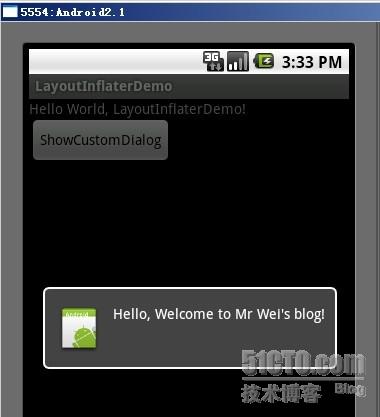LayoutInflater
来源:互联网 发布:网络ip范围计算 编辑:程序博客网 时间:2024/06/04 17:48
以下出自http://www.open-open.com/lib/view/open1328837587484.html
LayoutInflater作用是将layout的xml布局文件实例化为View类对象。
获取LayoutInflater的方法有如下三种:
?
LayoutInflater inflater=(LayoutInflater)context.getSystemService(Context.LAYOUT_INFLATER_SERVICE);View layout = inflater.inflate(R.layout.main, null);LayoutInflater inflater = LayoutInflater.from(context); (该方法实质就是第一种方法,可参考源代码)View layout = inflater.inflate(R.layout.main, null);LayoutInflater inflater = getLayoutInflater();(在Activity中可以使用,实际上是View子类下window的一个函数)View layout = inflater.inflate(R.layout.main, null);
getLayoutInflater():Activity的getLayoutInflater()方法是调用PhoneWindow的getLayoutInflater()方法,看一下该源代码: publicPhoneWindow(Contextcontext) { super(context); mLayoutInflater= LayoutInflater.from(context); }可以看出它其实是调用LayoutInflater.from(context)。LayoutInflater.from(context): public static LayoutInflaterfrom(Context context) { LayoutInflaterLayoutInflater = (LayoutInflater)context.getSystemService(Context.LAYOUT_INFLATER_SERVICE); if(LayoutInflater== null){ thrownew AssertionError("LayoutInflaternot found."); } returnLayoutInflater; }可以看出它其实调用context.getSystemService()。
一直有点纠结setContentView和inflate的区别找了一些资料。写了个小程序看了下:
?
publicclassMyInflate extendsActivity{ privateTextView tv; publicvoidOnCreate(Bundle savedInstanceState){ super.onCreate(savedInstanceState); //setContentView(R.layout.main); //tv = (TextView) findViewById(R.id.tv); LayoutInflater inflate = LayoutInflater.from(this); View view = inflate.inflate(R.layout.main,null); setContentView(view); }}上述注释掉的代码和没有注释掉的代码两种情况是相同的。
区别:
setContentView()一旦调用, layout就会立刻显示UI;而inflate只会把Layout形成一个以view类实现成的对象,有需要时再用setContentView(view)显示出来。一般在activity中通过setContentView()将界面显示出来,但是如果在非activity中如何对控件布局设置操作了,这就需要LayoutInflater动态加载。
public View inflate(int Resourece,ViewGroup root)
作用:填充一个新的视图层次结构从指定的XML资源文件中
reSource:View的layout的ID
root: 生成的层次结构的根视图
return 填充的层次结构的根视图。如果参数root提供了,那么root就是根视图;否则填充的XML文件的根就是根视图。
其余几个重载的inflate函数类似。
以下出自 “Android_Tutor” 博客,请务必保留此出处http://weizhulin.blog.51cto.com/1556324/311450
在实际开发种LayoutInflater这个类的作用类似于 findViewById(),
不同点是LayoutInflater是用来找layout下xml布局文件,并且实例化!而findViewById()是找具体xml下的具体 widget控件(如:Button,TextView等)。
为了让大家容易理解我做了一个简单的Demo,主布局main.xml里有一个TextView和一个Button,当点击Button,出现 Dialog,而这个Dialog的布局方式是我们在layout目录下定义的custom_dialog.xml文件(里面左右分布,左边 ImageView,右边TextView)。
效果图如下:

下面我将详细的说明Demo的实现过程:
1、新建一个 Android工程,我们命名为LayoutInflaterDemo.
2、修改main.xml布局,里面主要在原来基础上增加了一个Button.代码如下:
- view plaincopy to clipboardprint?
- <?xml version="1.0"
- encoding="utf-8"?>
- <LinearLayout
- xmlns:android="http://schemas.android.com/apk/res/android"
- android:orientation="vertical"
- android:layout_width="fill_parent"
- android:layout_height="fill_parent"
- >
- <TextView
- android:layout_width="fill_parent"
- android:layout_height="wrap_content"
- android:text="@string/hello"
- />
- <Button
- android:id="@+id/button"
- android:layout_width="wrap_content"
- android:layout_height="wrap_content"
- android:text="ShowCustomDialog"
- />
- </LinearLayout>
- <?xml version="1.0"
- encoding="utf-8"?>
- <LinearLayout
- xmlns:android="http://schemas.android.com/apk/res/android"
- android:orientation="vertical"
- android:layout_width="fill_parent"
- android:layout_height="fill_parent"
- >
- <TextView
- android:layout_width="fill_parent"
- android:layout_height="wrap_content"
- android:text="@string/hello"
- />
- <Button
- android:id="@+id/button"
- android:layout_width="wrap_content"
- android:layout_height="wrap_content"
- android:text="ShowCustomDialog"
- />
- </LinearLayout>
3.定义对话框的布局方式,我们在layout目录下,新建一个名为 custom_dialog.xml文件具体代码如下:
- view plaincopy to clipboardprint?
- <?xml version="1.0"
- encoding="utf-8"?>
- <LinearLayout
- xmlns:android="http://schemas.android.com/apk/res/android"
- android:orientation="horizontal"
- android:layout_width="fill_parent"
- android:layout_height="fill_parent"
- android:padding="10dp"
- >
- <ImageView android:id="@+id/image"
- android:layout_width="wrap_content"
- android:layout_height="fill_parent"
- android:layout_marginRight="10dp"
- />
- <TextView android:id="@+id/text"
- android:layout_width="wrap_content"
- android:layout_height="fill_parent"
- android:textColor="#FFF"
- />
- </LinearLayout>
- <?xml version="1.0"
- encoding="utf-8"?>
- <LinearLayout
- xmlns:android="http://schemas.android.com/apk/res/android"
- android:orientation="horizontal"
- android:layout_width="fill_parent"
- android:layout_height="fill_parent"
- android:padding="10dp"
- >
- <ImageView android:id="@+id/image"
- android:layout_width="wrap_content"
- android:layout_height="fill_parent"
- android:layout_marginRight="10dp"
- />
- <TextView android:id="@+id/text"
- android:layout_width="wrap_content"
- android:layout_height="fill_parent"
- android:textColor="#FFF"
- />
- </LinearLayout>
4.修改主程序LayouInflaterDemo.java代码如下:
- view plaincopy to clipboardprint?
- package com.android.tutor;
- import android.app.Activity;
- import android.app.AlertDialog;
- import android.content.Context;
- import android.os.Bundle;
- import android.view.LayoutInflater;
- import android.view.View;
- import android.view.View.OnClickListener;
- import android.widget.Button;
- import android.widget.ImageView;
- import android.widget.TextView;
- public class LayoutInflaterDemo extends Activity implements
- OnClickListener {
- private Button button;
- public void onCreate(Bundle savedInstanceState) {
- super.onCreate(savedInstanceState);
- setContentView(R.layout.main);
- button = (Button)findViewById(R.id.button);
- button.setOnClickListener(this);
- }
- @Override
- public void onClick(View v) {
- showCustomDialog();
- }
- public void showCustomDialog()
- {
- AlertDialog.Builder builder;
- AlertDialog alertDialog;
- Context mContext = LayoutInflaterDemo.this;
- //下面俩种方法都可以
- ////LayoutInflater inflater = getLayoutInflater();
- LayoutInflater inflater = (LayoutInflater)
- mContext.getSystemService(LAYOUT_INFLATER_SERVICE);
- View layout = inflater.inflate(R.layout.custom_dialog,null);
- TextView text = (TextView) layout.findViewById(R.id.text);
- text.setText("Hello, Welcome to Mr Wei's blog!");
- ImageView image = (ImageView) layout.findViewById(R.id.image);
- image.setImageResource(R.drawable.icon);
- builder = new AlertDialog.Builder(mContext);
- builder.setView(layout);
- alertDialog = builder.create();
- alertDialog.show();
- }
- }
- package com.android.tutor;
- import android.app.Activity;
- import android.app.AlertDialog;
- import android.content.Context;
- import android.os.Bundle;
- import android.view.LayoutInflater;
- import android.view.View;
- import android.view.View.OnClickListener;
- import android.widget.Button;
- import android.widget.ImageView;
- import android.widget.TextView;
- public class LayoutInflaterDemo extends Activity implements
- OnClickListener {
- private Button button;
- public void onCreate(Bundle savedInstanceState) {
- super.onCreate(savedInstanceState);
- setContentView(R.layout.main);
- button = (Button)findViewById(R.id.button);
- button.setOnClickListener(this);
- }
- @Override
- public void onClick(View v) {
- showCustomDialog();
- }
- public void showCustomDialog()
- {
- AlertDialog.Builder builder;
- AlertDialog alertDialog;
- Context mContext = LayoutInflaterDemo.this;
- //下面俩种方法都可以
- ////LayoutInflater inflater = getLayoutInflater();
- LayoutInflater inflater = (LayoutInflater)
- mContext.getSystemService(LAYOUT_INFLATER_SERVICE);
- View layout = inflater.inflate(R.layout.custom_dialog,null);
- TextView text = (TextView) layout.findViewById(R.id.text);
- text.setText("Hello, Welcome to Mr Wei's blog!");
- ImageView image = (ImageView) layout.findViewById(R.id.image);
- image.setImageResource(R.drawable.icon);
- builder = new AlertDialog.Builder(mContext);
- builder.setView(layout);
- alertDialog = builder.create();
- alertDialog.show();
- }
- }
另外getSystemService()是Android很重要的一个API,它是Activity的一个方法,根据传入的NAME来取得对应的Object,然后转换成相应的服务对象。以下介绍系统相应的服务。
传入的Name 返回的对象 说明
WINDOW_SERVICE WindowManager管理打开的窗口程序
LAYOUT_INFLATER_SERVICE LayoutInflater 取得xml里定义的view
ACTIVITY_SERVICE ActivityManager管理应用程序的系统状态
POWER_SERVICE PowerManger电源的服务
ALARM_SERVICE AlarmManager闹钟的服务
NOTIFICATION_SERVICE NotificationManager状态栏的服务
KEYGUARD_SERVICE KeyguardManager键盘锁的服务
LOCATION_SERVICE LocationManager位置的服务,如GPS
SEARCH_SERVICE SearchManager搜索的服务
VEBRATOR_SERVICE Vebrator手机震动的服务
CONNECTIVITY_SERVICE Connectivity网络连接的服务
WIFI_SERVICE WifiManagerWi-Fi服务
TELEPHONY_SERVICE TeleponyManager电话服务
inflate 方法
通过 sdk 的 api 文档,可以知道该方法有以下几种过载形式,返回值均是 View 对象,如下:
public View inflate (int resource, ViewGroup root)
public View inflate (XmlPullParser parser, ViewGroup root)
public View inflate (XmlPullParser parser, ViewGroup root, boolean attachToRoot)
public View inflate (int resource, ViewGroup root, boolean attachToRoot)
示意代码:
LayoutInflater inflater = (LayoutInflater)getSystemService(LAYOUT_INFLATER_SERVICE);
View view = inflater.inflate(R.layout.custom, (ViewGroup)findViewById(R.id.test));
//EditText editText = (EditText)findViewById(R.id.content);// error
EditText editText = (EditText)view.findViewById(R.id.content);
对于上面代码,指定了第二个参数 ViewGroup root,当然你也可以设置为 null 值。
注意:
·inflate 方法与 findViewById 方法不同;
·inflater 是用来找 res/layout 下的 xml 布局文件,并且实例化;
·findViewById() 是找具体 xml 布局文件中的具体 widget 控件(如:Button、TextView 等)。
0 0
- LayoutInflater
- LayoutInflater
- LayoutInflater
- LayoutInflater
- LayoutInflater
- LayoutInflater
- LayoutInflater
- LayoutInflater
- LayoutInflater
- LayoutInflater
- LayoutInflater
- LayoutInflater
- LayoutInflater
- LayoutInflater
- LayoutInflater
- LayoutInflater
- LayoutInflater
- LayoutInflater
- 如何才能在Eclipse下写cocos2d程序
- POJ 3411 Paid Roads(搜索的小技巧)
- Windows 7环境变量与路径的一一对应关系
- C#中comboBox控件的一些基本用法小结
- 【Java TCP/IP Socket】UDP Socket(含代码)
- LayoutInflater
- in the previous lessons我们遗传的
- matlab的数据类型 对比 OpenCV
- Mat 版本SVM训练程序
- Hibernate错误:Unable to instantiate default tuplizer
- Day14 - groupmod 更改群组属性
- skiing
- 堆和栈的区别(转过无数次的文章)
- POI Excel 工具类


